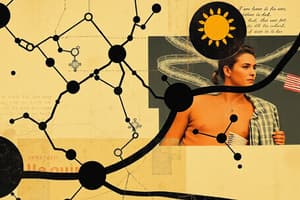Podcast
Questions and Answers
What are the functions of nucleotides? (Select all that apply)
What are the functions of nucleotides? (Select all that apply)
- Adenine nucleotides used for cofactors that facilitate pathways (correct)
- Signaling and metabolic pathways (correct)
- Polysaccharide synthesis (correct)
- ATP is an energy source in all required pathways (correct)
- DNA and RNA synthesis (correct)
What is the function of ATP?
What is the function of ATP?
Energy and cofactors
What is the function of GTP?
What is the function of GTP?
G protein signaling
What is the function of CTP?
What is the function of CTP?
What is the function of UTP?
What is the function of UTP?
What three components make up a nucleotide?
What three components make up a nucleotide?
How are nucleotide components combined?
How are nucleotide components combined?
What are the two classes of bases that make up nucleotides?
What are the two classes of bases that make up nucleotides?
Which bases are found in DNA?
Which bases are found in DNA?
Which bases are found in RNA?
Which bases are found in RNA?
What is the difference between a ribonucleotide and a ribonucleoside?
What is the difference between a ribonucleotide and a ribonucleoside?
What deoxyribonucleotide is important in metabolism but not incorporated into DNA?
What deoxyribonucleotide is important in metabolism but not incorporated into DNA?
What happens in the first committed step of purine de novo synthesis?
What happens in the first committed step of purine de novo synthesis?
Why is pyrimidine de novo synthesis considered modular while purine synthesis is not?
Why is pyrimidine de novo synthesis considered modular while purine synthesis is not?
What enzymes convert nucleoside monophosphates to nucleoside diphosphates?
What enzymes convert nucleoside monophosphates to nucleoside diphosphates?
What converts nucleoside diphosphates to nucleoside triphosphates?
What converts nucleoside diphosphates to nucleoside triphosphates?
What are the three types of reactions for the salvage pathway?
What are the three types of reactions for the salvage pathway?
Where do molecules to be salvaged come from?
Where do molecules to be salvaged come from?
What are the key control points in the de novo purine synthesis pathway?
What are the key control points in the de novo purine synthesis pathway?
What mechanisms contribute to providing an appropriate balance of ATP and GTP production?
What mechanisms contribute to providing an appropriate balance of ATP and GTP production?
How can an HGPRT deficiency cause Lesch-Nyhan Syndrome?
How can an HGPRT deficiency cause Lesch-Nyhan Syndrome?
How is it that eukaryotes and prokaryotes have different first committed steps in the pyrimidine de novo synthesis pathway?
How is it that eukaryotes and prokaryotes have different first committed steps in the pyrimidine de novo synthesis pathway?
What are eukaryotes inhibited by in de novo pyrimidine synthesis?
What are eukaryotes inhibited by in de novo pyrimidine synthesis?
Why are certain enzymes of nucleotide synthesis regulated according to the cell cycle? Give 3 examples.
Why are certain enzymes of nucleotide synthesis regulated according to the cell cycle? Give 3 examples.
Flashcards are hidden until you start studying
Study Notes
Functions of Nucleotides
- Key roles include DNA/RNA synthesis, signaling, and metabolism.
- ATP serves as the primary energy source across multiple pathways.
- Adenine nucleotides act as cofactors facilitating biochemical processes.
- Nucleotide derivatives are essential for polysaccharide synthesis.
ATP and Other Nucleotides
- ATP acts as an energy source and cofactor in various cellular reactions.
- GTP is involved in G protein signaling pathways.
- CTP contributes to the synthesis of lipid precursors such as phospholipids and sphingolipids.
- UTP is integral for forming UDP sugars, which are precursors for polysaccharides.
Structure of Nucleotides
- Nucleotides consist of three components: a sugar, a nitrogenous base, and a phosphate group.
- Nucleotides are formed through glycosidic bonds between sugars and bases, and phosphodiester bonds between sugars and phosphates.
Classes and Bases of Nucleotides
- Two classes of nitrogenous bases: purines (A, G) and pyrimidines (C, T/U).
- DNA bases include adenine (A) and thymine (T); guanine (G) pairs with cytosine (C).
- RNA bases substitute uracil (U) for thymine, pairing with adenine (A) and guanine (G) with cytosine (C).
Differences in Nucleotides
- Ribonucleotides contain a phosphate group, while ribonucleosides lack it.
- dUMP is a deoxyribonucleotide crucial for metabolism but is not integrated into DNA.
Synthesis Pathways
- The first committed step of purine de novo synthesis involves converting PRPP to beta-5-phosphoribosylamine.
- Pyrimidine synthesis is modular; the base is synthesized first and then attached to ribose.
- Purine synthesis requires adding nitrogen to PRPP to build the base.
Enzymatic Conversion
- Nucleoside monophosphates (NMPs) convert to diphosphates (NDPs) via specific kinases.
- NDPs are phosphorylated to nucleoside triphosphates (NTPs) by nucleoside diphosphate kinase.
Salvage Pathway Mechanisms
- Key reactions in the salvage pathway include nucleoside phosphorylases, nucleoside kinases, and phosphoribosyl transferases.
- Salvaged nucleotides primarily originate from dietary sources and degraded nucleic acids.
Regulation in Purine Synthesis
- Negative control: High levels of AMP and GMP inhibit steps leading to adenylosuccinate and XMP.
- Positive control: Abundant PRPP activates amidophosphoribosyl transferase; GTP enhances IMP conversion to adenylosuccinate; ATP promotes XMP to GMP.
- Balances ATP and GTP production through energy contributions.
Lesch-Nyhan Syndrome
- Caused by HGPRT deficiency, leading to PRPP overaccumulation.
- Excess PRPP stimulates unwanted de novo purine synthesis, resulting in elevated uric acid and neurological issues.
Eukaryotic vs Prokaryotic Pathways
- Eukaryotes utilize CPSII, while prokaryotes use CPS followed by ATCase for pyrimidine synthesis.
- These enzymes differ in location and regulation despite their catalytic similarities.
Regulation in Pyrimidine Synthesis
- Eukaryotic CPSII is regulated by the nucleotide UTP derived from UDP.
- Enzyme regulation may vary according to the cell cycle, ensuring proper nucleotide availability during DNA replication and repair processes.
Studying That Suits You
Use AI to generate personalized quizzes and flashcards to suit your learning preferences.




